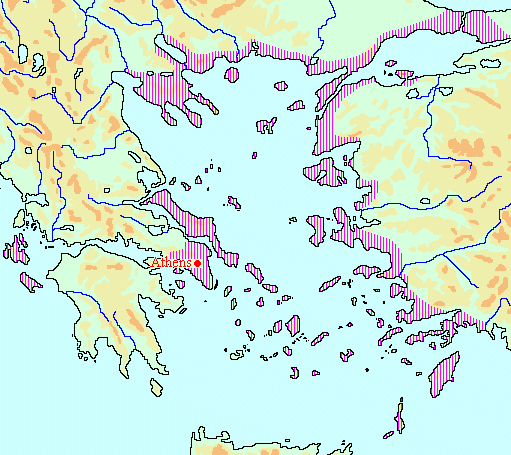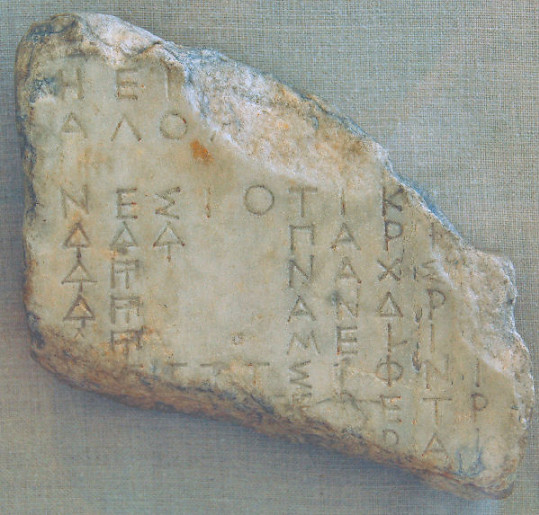Delian League
Delian League: modern name of the Athenian alliance, founded after the Persian Wars as a military organization directed against the Achaemenid Empire, but converted by the Athenian politician Pericles into an Athenian empire. In the Peloponnesian War (431-404 BCE), the Spartans tried to force the Athenians to give up the Delian League.
Origin

In 480, the Persian king Xerxes invaded Greece, defeated his enemies at Artemisium and Thermopylae, and sacked Athens. Although his navy was severely damaged in the naval battle of Salamis, it was obvious that the Persians were the strongest. So, the great king recalled many troops. This gave the Greeks the breathing space they needed, and they defeated Xerxes' right-hand man Mardonius at Plataea. More or less at the same time, a Greek expeditionary force attacked the remains of the Persian navy at Mycale, and started to liberate the Greek towns in Asia Minor.
In 478, the Spartan prince Pausanias led a Greek expeditionary force to Byzantium. If he would take the city, the Greeks would control the Bosphorus and could keep the Persians out of Europe. However, Pausanias lost authority when rumors were spread that he wanted to collaborate with the satrap of nearby Hellespontine Phrygia, Artabazus. He was recalled by the Spartan authorities, and the Athenian Aristides, who may have been behind the rumors, took over the command of the Greek army.
Although Pausanias was cleared of all accusations, the Spartans now decided to remain outside the war against Persia. For Sparta, the main war aims had been reached now that a cordon sanitaire had been created in Asia Minor. If the Persians wanted to return to Europe, they first had to occupy the towns of the liberated Ionian Greeks. The Athenians had a different perspective. They felt related to the Ionians, and in their view, security could only be reached when their compatriots were safe as well. Therefore, they continued the struggle and founded the Delian League.
From the very first beginning, there appears to have been an element of rivalry with Sparta, as is suggested by the author of the Constitution of the Athenians, a little treatise that is (probably incorrectly) attributed to Aristotle of Stagira:
Aristides saw that the Spartans had gained a bad reputation because of Pausanias and urged the Ionians to break away from the Spartan alliance. For that reason it was he who made the first assessment of the tribute of the cities, in the third year after the battle of Salamis, in the archonship of Timosthenes, and who swore the oaths to the Ionians that they should have the same enemies and friends, to confirm which they sank lumps of iron in the sea.note
This is an interesting quote. It does not refer to Persia, as we should have expected. It is also absent from the History of the Peloponnesian War by the Athenian historian Thucydides, who says that the war against the Persians was just a pretext. It appears that from the very beginning, the allies wanted more: the Delian League, as it is called, was a pact of mutual assistance against all possible enemies, and this implied Sparta and the Peloponnesian League. In fact, the members were embarking upon something bigger and perhaps their alliance should be called "the Ionian League".
In any case, the Ionian card was played. The oaths were sworn at Delos, the little island on which the Ionian Greeks venerated the god Apollo. (Dorians preferred Delphi.) Delos also was to be the treasury, and the Ionians recognized Athens as metropolis, a word that can be translated as "mother city" and was often used to describe the native country of the founder of a colony. The metropolis always had some informal, religious (and sometimes even formal, political) rights in the "daughter city". For example, centuries after Potideia had been founded by Corinth, the Corinthians still sent magistrates to their colony.
The creation of "Ionianism" was the most important aspect of the Delian League, and the more formal conditions of membership were not very elaborate. The allies were to have the same enemies, were to refrain from violence against each other, took a seat in the League's council, and had to take a share in the common wars. The strongest allies provided ships; towns that were unable to maintain ships provided the Athenians with money, so that they could build extra ships and protect them. This was an attractive option, because Athens demanded less money than the towns would have spent on their own defense. (This was the phoros, a word translated as "tribute" in the quotation above.)
Inspiration
Paying tribute was a novelty. The Spartan alliance, the Peloponnesian League, did not ask money, only soldiers, and we hear nothing about financial contributions in other Greek political (con)federations. However, they were all land-based, and the Athenian alliance was not. Maritime political organizations demand another kind of organization.
We must not underestimate the originality of the new alliance, but neither must we close our eyes for the fact that there was a well-known example: the western part of the Achaemenid Empire, with its maritime lines of communication and active navy, must have been an important source of inspiration. The system of financial tribute had been designed by king Darius I the Great (522-486), who understood that his kingdom was too large to ask only soldiers and presents from his subjects. To control the western territories - Libya, Egypt, Phoenicia, Cilicia, Cyprus, Lycia, Caria, Ionia - he needed a fleet, and to pay the rowers, he needed cash. The result was the monetarization of the tribute.
There are other parallels between the Persian empire and the Delian League. The crews of the galleys of the Persian navy were from various parts of the empire, and in fact, for many towns on Cyprus and in Phoenicia, manning ships was a way to earn the money they needed to pay the tribute. The Athenians did the same: their ships were partly manned by the allies, who received fair wages, spent their money at home, where the authorities obtained their share and paid tribute.
Another aspect that the Athenians copied from the Persians was the appointment of an overseer, the episcopus. This Athenian magistrate kept an eye on the town where he resided, controlled the payment of the tributes, was supposed to prevent insurrections, had to investigate evils, and reported them to the government at home. The Achaemenid model is the "eye of the king". He was appointed by the king to inform him of what was going on in the empire, had more powers than the satraps, was responsible for a well-defined region, supervised the policy of the satraps and the payment of tribute, oversaw how rebellions were suppressed, and reported evils to the king. The Persian title of this official is unknown, but may have been spasaka ("seer"). If so, episkopos (which also has an association with "to see") is a translation that remains close to the sound of the original.
It is also interesting to take a look at the division of the League into five fiscal districts:
- Thrace (the northern Aegean): 62 towns, of which Ainos, Argilos, Mende, Potideia, Samothrace, Scione, Sermylia, Strepsa, Thasos, and Torone paid more than five talents.
- Hellespont: 45 towns, Abydus, Byzantium, Chalcedon, the Chersonese, Cyzicus, Lampsacus, Perinthus, and Selymbria paying more than five talents.
- Ionia (the eastern Aegean): 35 towns, including Cyme, Ephesus, Erythrae, Miletus, and Teos.
- Caria: 81 towns, including Camirus, Cnidus, Cos, Ialysus, Lindus, Phaselis, and Telmessus.
- and the islands: 29 towns, including Andros, Carystus, Chalcis, Eretria, Naxos, and Paros.
Thrace, the Hellespont, Ionia, Caria, and the Greek islands are not self-defined areas. There's no natural border between Thrace and the Hellespont or between Caria and Ionia, nor are these districts ethnic unities. However, they neatly correspond with five units that were distinguished by the Persian government: Skudra, Hellespontine Phrygia, the Yaunâ on this side of the sea, Karka, and the Yaûna across the sea.
Development
As long as a Persian attack remained possible, the members of the League had good reasons to remain united, but king Xerxes accepted the loss of peripheral countries that were too expensive to occupy. Instead, he preferred to consolidate his grip on rich satrapies like Babylonia and Lydia. Already in 472, when the Athenian playwright Aeschylus wrote his tragedy The Persians, it was believed that the Greeks had won the war and that the battle of Salamis had been decisive. If it had not been clear from the very beginning that the Delian League was not only directed against Persia, it must have been recognized in the late 470s.
Naxos and Carystus were the first to segregate, but were visited by the Athenian navy and forced into surrender (470). Five years later, Thasos suffered the same fate. There were other insurrections in the course of the next decades. The defeated towns were forced to remain in the League and if they had not been democratic yet, they were obliged to change their constitution. On several places, Athenian colonies (clerurchies) were founded. Defeated towns also lost some autonomy, had to disband their navies, and were to pay tribute in cash. The last-mentioned measure made a second revolt almost impossible, because the defeated town that was dreaming of an insurrection was actually paying the army that would come to suppress the rebellion.
Slowly, Athens was converting the league into an empire. In 461, war broke out with Sparta, a conflict that almost naturally implied an ideological struggle between Ionianism and Dorianism, concepts that focused on leadership by Athens and Sparta. At the same time, the Delian League supported Inarus, an Egyptian who led a revolt against the Persians. The League lost an expeditionary force, and the Athenians immediately said that in this crisis, the treasury should be removed from the little island of Delos to a stronger citadel - the acropolis of Athens.

In 446, Athens and Sparta signed a peace treaty, and recognized each other as leaders of an alliance. (Perhaps the Athenians had signed a similar treaty with the Persian king in 449.) After this, the Athenians started to speak about "the cities which the Athenians rule". The transition of the League from a mutual defense organization into an empire was complete, and in the next ten years, we see an increasing Athenian involvement in local affairs. Trials involving an Athenian were to be held in Athens, the Athenians controlled the economy of the member states, represented them in negotiations with Sparta or Persia, and felt free to use the tribute for its own purposes. The splendid Parthenon temple, with its remarkable Ionian influences, is but one example to illustrate that Athens behaved like an imperialistic power that felt free to use war contributions for other purposes.
By the 430s, the Athenian empire had become very unpopular. The Greek historian Herodotus of Halicarnassus, who described the Persian War, felt that he had to apologize for saying that the Athenians had once defeated the Persians. The implication is that by then, it was widely believed that Sparta alone had defended Greek liberty, and that Athens had become an oppressor like Persia. It was in this climate that the Corinthians convinced the Spartans that they had to liberate the Greeks for the second time. In the spring of 431, the Archidamian War broke out, in which Sparta, Corinth, and Thebes tried to force Athens to give up the Delian League.